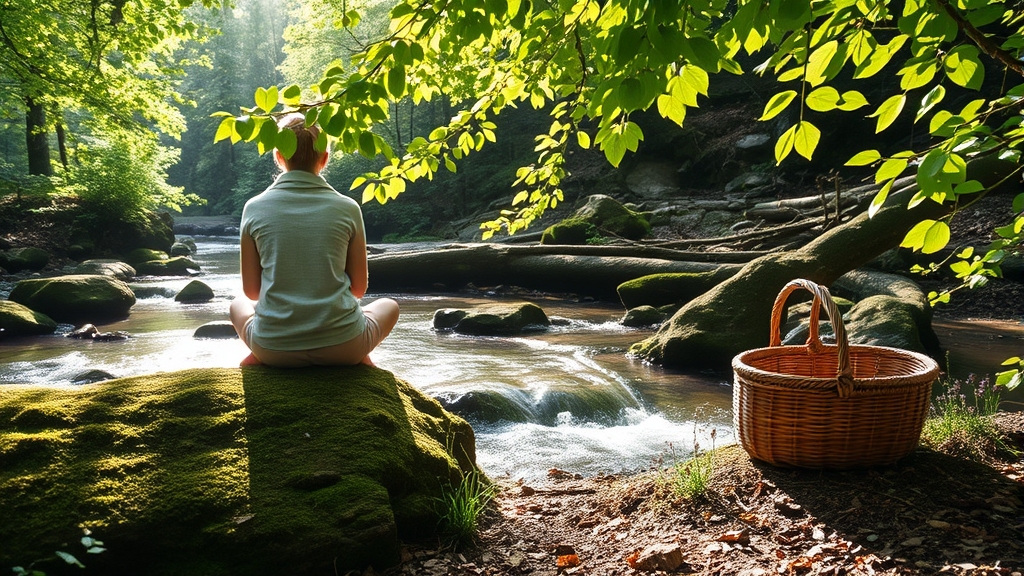Embracing a nature-paced lifestyle invites you to slow down, connect with your surroundings, and savor each moment. By practicing mindful eating, spending time outdoors, and creating tranquil spaces with biophilic design, you can deepen your bond with nature. Simplifying your schedule and focusing on meaningful experiences helps reduce stress and burnout. Keep exploring how small, intentional changes can transform your life into a more fulfilling, sustainable journey.
Key Takeaways
- Incorporate mindful practices like savoring each moment and food to foster presence and reduce stress.
- Connect with nature through outdoor activities, gardening, and biophilic design to enhance well-being.
- Simplify routines and declutter spaces to create a calm, intentional environment aligned with natural rhythms.
- Reevaluate priorities to include quiet reflection, outdoor walks, and hobbies that restore energy.
- Choose sustainable habits such as local, organic food and eco-friendly products to support harmony with nature.

Have you ever felt overwhelmed by the constant rush of modern life? It’s easy to get caught up in the hustle, juggling deadlines, notifications, and never-ending to-do lists. But what if you slowed down, embraced a more intentional approach, and started living in tune with nature’s rhythm? That’s the essence of slow living: a deliberate shift towards a calmer, more meaningful existence. It begins with small changes, like practicing mindful eating. Instead of rushing through meals or multitasking while eating, you focus on each bite, savoring the flavors, textures, and aromas. This simple act encourages you to be present, fostering a deeper appreciation for your food and the effort behind it. As you cultivate this mindful eating habit, you also become more aware of your consumption patterns, which naturally leads to adopting sustainable habits. You start choosing locally sourced, organic produce, reducing waste, and supporting environmentally friendly practices. These choices align with the slow living philosophy, emphasizing quality over quantity and mindful stewardship of resources. Additionally, understanding your personality traits can help tailor your slow living journey to fit your unique preferences and tendencies. Incorporating sustainable habits into your daily routine can further enhance your connection with nature and promote a more balanced lifestyle. Recognizing the importance of biophilic design can also help create environments that foster tranquility and well-being indoors. Moreover, integrating nature-based activities like gardening or outdoor meditation can deepen your appreciation for natural cycles and support your overall well-being.
Furthermore, engaging with outdoor spaces like your garden or greenhouse can deepen your appreciation for natural cycles and promote a more nature-oriented mindset, enhancing your overall sense of harmony and peace. Adopting a slow-paced lifestyle doesn’t mean abandoning productivity; it’s about re-evaluating your priorities and making space for what truly matters. You might set aside time each day for quiet reflection, outdoor walks, or engaging in hobbies that restore your energy. By consciously slowing down, you allow yourself to reconnect with your surroundings, your thoughts, and your feelings. This intentional approach helps you build resilience against stress and burnout, giving you a clearer perspective on what’s essential. Over time, you’ll notice how these small shifts foster a sense of fulfillment and peace.
Living more slowly also encourages you to develop sustainable habits that extend beyond just your diet. It might mean simplifying your schedule, choosing to spend quality time with loved ones, or decluttering your space to create a calmer environment. These changes support a lifestyle where you’re more connected to the present moment and less driven by consumerism. You realize that a slower pace doesn’t mean less productivity but rather a more thoughtful, efficient use of your energy. As you embrace this way of living, you’ll find that life becomes richer and more authentic. It’s a conscious decision to prioritize well-being, harmony with nature, and meaningful experiences over the constant chase for more. In doing so, you create a life that’s not only sustainable for the planet but also deeply fulfilling for you.
Frequently Asked Questions
How Can I Start Practicing Slow Living in a Busy City?
To start practicing slow living in a busy city, find moments of urban tranquility by visiting local parks or quiet cafes. Create a city escape by dedicating time for mindful walks or meditation away from the hustle. Simplify your daily routine and focus on quality over quantity. By intentionally slowing down, you’ll enjoy a calmer, more balanced life, even amid the city’s energy.
What Are Simple Daily Habits to Adopt a Slower Lifestyle?
To adopt a slower lifestyle, start with mindful routines like savoring your morning coffee or taking short, focused breaks during your day. Make intentional choices, such as reducing multitasking and setting boundaries around work and leisure. Practice deep breathing or a quick walk outside to reconnect with the present moment. These small daily habits help you slow down, reduce stress, and create a more balanced, peaceful life amid a busy schedule.
How Does Slow Living Impact Mental Health and Stress Levels?
Ever wonder how slowing down can improve your mental health? By adopting slow living, you naturally incorporate mindfulness practices and stress reduction techniques into your daily routine. This approach helps you stay present, reduces anxiety, and enhances emotional resilience. As you prioritize quality over speed, you’ll notice your stress levels decrease, and your overall well-being improve. Isn’t it time to embrace a calmer, more centered lifestyle for better mental health?
Can Slow Living Improve Relationships With Family and Friends?
Focusing on slow living can definitely improve your relationships with family and friends. By prioritizing quality time, you create meaningful moments that foster deeper emotional connections. When you slow down, you listen more attentively and share experiences more intentionally, which strengthens bonds. This mindful approach helps you appreciate loved ones more fully, leading to healthier, more supportive relationships built on genuine understanding and connection.
What Are Common Challenges Faced When Transitioning to Slow Living?
Imagine your life as a delicate balance act on a tightrope; shifting to slow living feels like taking smaller, more mindful steps. You’ll face challenges like managing time effectively, as the rush of daily demands pulls you in different directions. Social expectations may tempt you to rush back into hurried routines, but with patience, you’ll find harmony. Embrace these hurdles as opportunities to craft a more intentional, peaceful rhythm.
Conclusion
Embracing slow living means you’re choosing to savor each moment, like a gentle stream flowing steadily through the landscape. It’s about finding beauty in simplicity and letting nature’s rhythm guide you. When you slow down, life becomes more meaningful, much like a song played with deliberate care. So, take a breath, enjoy the pause, and remember that sometimes, the best things in life unfold at a gentle, unhurried pace.







